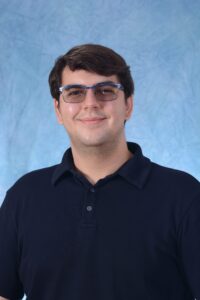In this new Vital Signs series, we feature graduate student Max Hockenberry, who performs research in the labs of Wes Legant, PhD, and Jim Bear, PhD. Hockenberry is developing new microscopy methods so researchers can measure the mechanisms cells use to maneuver through tight spaces in the body.

Max Hockenberry is a joint PhD student in the labs of Wes Legant, PhD, assistant professor of pharmacology, and James Bear, professor of cell biology and physiology, with a joint appointment in pharmacology, at the UNC School of Medicine. Both are UNC Lineberger members. In the lab, Hockenberry is developing a new microscopy method so that researchers can how cells exert force to squeeze through small spaces as they migrate within the body.
Q: What were your interests when young, and how did you get into biomedical science?
A: Growing up, I was all about astronomy – obsessed with the mysteries of space and always lost in a sci-fi novel. But I reached a turning point during a senior research project in high school. That first time peering through a microscope at a sample of pond water was a game-changer. It was like discovering a whole new universe right in front of me, just as mind-blowing as anything in space. But this time, I could interact with it directly. That moment fueled a new passion, guiding me toward a path in biomedical science where I could get hands-on with the incredible intricacies of life.
Q: Why did you choose UNC and the lab you are in?
A: I have been involved in research at UNC for many years. I attended UNC for my undergraduate degrees and became involved in the research community almost immediately. What drew me back to UNC for graduate school was the impressive array of multidisciplinary research opportunities, the genuinely collaborative atmosphere, and the cytoskeleton research community. This atmosphere fueled my curiosity and set the stage for my academic journey.
Joining the labs of Wes Legant and Jim Bear was a natural choice for me. Their focus on molecular biology, cutting-edge microscopy techniques, and the intricacies of the cytoskeleton resonated with my scientific interests. What stood out was the chance to amalgamate advanced microscopy, material and microdevice engineering, and molecular biology under the guidance of experienced mentors. This dynamic combination of expertise and the prospect of pushing boundaries in scientific exploration made joining their labs a compelling decision for me.
Q: What are you working on right now?
A: I am focused on developing a novel traction force microscopy protocol. This innovative method aims to measure the forces exerted by cells as they navigate through micron-scale confinements. We want to uncover the physical mechanisms employed by cells to maneuver through tight spaces, which mirrors real-life scenarios encountered during migration within the body or in disease states such as cancer metastasis. The insights gained from this protocol not only enhance our understanding of cellular behavior but also hold potential implications for addressing challenges in various pathological conditions.
Q: What inspires you the most about working in your field?
A: What inspires me most about working in my field is the constant innovation and pushing of boundaries by my colleagues. Witnessing the relentless pursuit of understanding living cells through cutting-edge technology is truly motivating. The field is dynamic, with advancements like super-resolution microscopy and sophisticated computational techniques providing unprecedented insights into the nature of single molecules.
The genetic engineering of optogenetic tools has opened up new frontiers, reshaping our understanding of cellular processes. It’s a thrilling journey, as I find myself regularly astounded by articles that challenge my preconceptions and reshape my perspectives on seemingly solved problems. This continuous evolution and the collaborative spirit within the scientific community make every day in this field an exciting exploration of the unknown.
Q: What are your goals after earning your PhD?
A: After completing my PhD, I hope to embark on a career in academia, where I can seamlessly blend my passion for research with a focus on the multi-scale interactions of the cytoskeleton. Unraveling the intricacies that underlie cellular functions like migration and cell division continues to captivate my interest. In the long term, I envision leading my own research laboratory, leveraging the diverse skills I’ve acquired.
My goal is to contribute to the field by addressing challenging biological questions, particularly in areas such as cancer metastasis or immune response. I am enthusiastic about the prospect of integrating cutting-edge technology with these complex biological inquiries to make meaningful contributions to our understanding of cellular processes and their implications in health and disease.